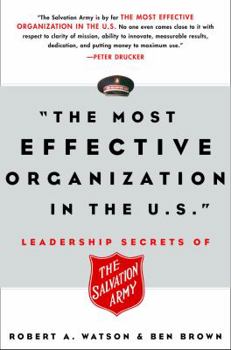The Most Effective Organization in the U.S.: Leadership Secrets of the Salvation Army
Select Format
Select Condition 
Book Overview
The book about not just business but the meaning of life ... a guide for being the best at what you do and doing it with a sense of purpose that connects with something larger than yourself ... For... This description may be from another edition of this product.
Format:Hardcover
Language:English
ISBN:060960869X
ISBN13:9780609608692
Release Date:November 2001
Publisher:Crown Business
Length:256 Pages
Weight:0.90 lbs.
Dimensions:0.9" x 5.8" x 8.6"
Customer Reviews
3 ratings
Leadership
Published by Thriftbooks.com User , 21 years ago
This is actually an interesting book. It tells the reader how the Salvation Army is an effective orgainzation. I bought this book for a college management class assignment on leadership and found the book to be very helpful.
Food for thought, not a how-to guide
Published by Thriftbooks.com User , 22 years ago
Disclaimer: I was a civilian employee of The Salvation Army (i.e., I am not an officer or a Salvationist) for five-and-a-half years, and I am an academic sociologist by training. This book is not a cookbook for effective leadership. You can't read this book, apply a couple of techniques, and expect to be as effective as The Salvation Army is at raising funds, running programs, and improving communities. If you are interested in effective leadership and you're willing to reflect on your practices and, more importantly, the principles underlying your business and/or management style, this is a book you should consider reading. If you're looking for some sort of quick-fix to improve your own management, look elsewhere. Instead, this book provides several general guidelines with supporting commentary drawn largely from Watson's experience as an officer with (and ultimately the National Commander, or Commissioner, of) The Salvation Army. According to Watson, the central tenet of The Salvation Army's leadership effectiveness is to, "engage the spirit." The remainder of the book elaborates on this point with other related ideas (i.e., put people in your purpose; embody the brand; lead by listening; spread the responsibility, share the profits; organize to improvise; act with audacity; and make joy count). Watson and Brown don't tell you specifically *how* to do these things, but provide examples of how The Salvation Army and, in some cases, other companies and executives accomplish these things. To be clear, the book isn't about The Salvation Army itself or its operations. You can gain insight into some of The Army's programs, but they vary too much from one community to the next to get a sense of the massive scope of what they do.
Engaging the Spirit, Mind, Body, Family, and Community!
Published by Thriftbooks.com User , 22 years ago
The Salvation Army's role and effectiveness may be the best-kept secret that is out in the open for all to see.Reading this book is a deeply moving spiritual experience. " . . . [T]he real secret of our success is getting them [those the Salvation Army serves] to accept responsibility for integrating their hearts, their minds, their souls with transcendent purpose." In grading this book, I was most heavily influenced by how much it added to my knowledge of the Salvation Army (clearly a five star operation) as an organization, and its key leadership and management principles. Like most people, I mainly know about the Salvation Army through tiny glimpses of its work as seen in good neighborhoods (while most of the work takes place in more challenging environments) . . . rather than as a case history in organizational effectiveness. Now, as a result of reading this book, I can see the whole a little and see it as being much more than the sum of the pieces. Compared to the potential to tell the Salvation Army's story, however, you may find that this book could be improved upon. I certainly did. The examples from businesses, sports, and music as well as the many references to famous management books usually just stole space, in my judgment, from telling more about the Salvation Army. A more useful counterpoint in the book would have been to explain how for-profit organizations fare in performing many of the same tasks that the Salvation Army does. I'm also not sure that the book totally captured the full lesson of the power of the Salvation Army's mission: Potential and actual volunteers and donors, those who need the Salvation Army's services, the families of those who need the Salvation Army's services, and the communities in which the Salvation Army operates (regardless of religious faith and personal beliefs) find the Salvation Army's purposes of principles to be inspiring and worthy of both active and moral support. In this dimension, the closest I can think of another organization for its mission's powerful appeal is Habitat for Humanity. As a student of leadership and management, I came away totally awed by thinking about how you provide services over 30 million people with around 5500 executives and managers (about a third of whom are "retired") in so many different, difficult activities: alcohol and drug rehabilitation; rehabilitating prisoners; helping homeless people get back to normal living; community recreation; disaster relief; rebuilding communities after disasters; and providing for the poor. The Salvation Army takes justifiable interest in measuring how effectively it performs these tasks compared to other organizations. The comparisons are usually very favorable. To put this in perspective, did you know that the Salvation Army had its first portable canteen on the scene within 20 minutes after the Oklahoma City bombing? Within minutes, three canteens were there. Then, I was totally flattened to realize that those w





